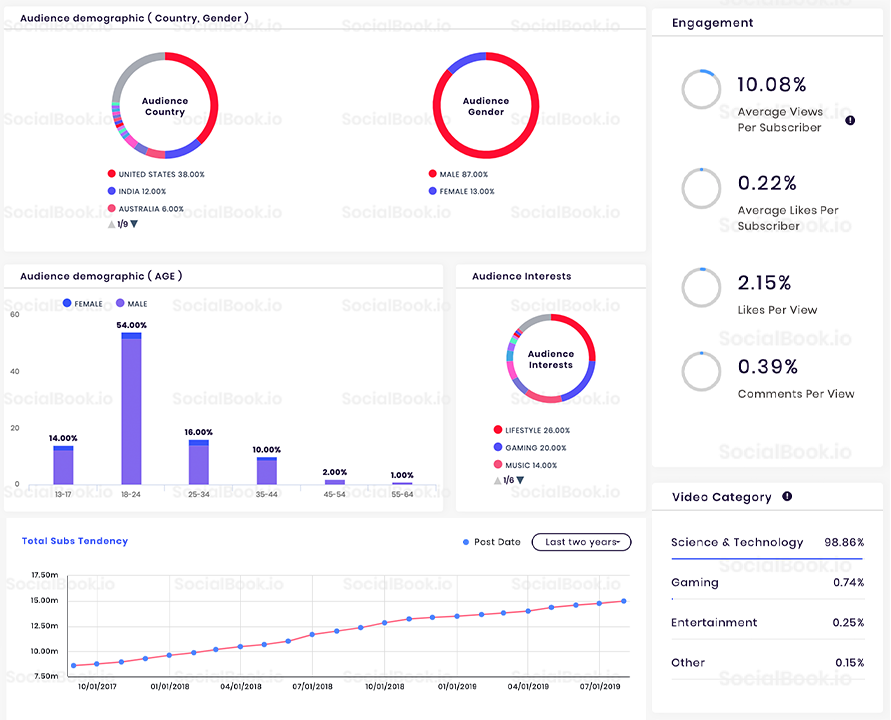YouTube is rapidly becoming one of the most popular influencer marketing channels. With recent improvements in internet speeds, video is now an expected part of most people's online experiences. While you will find videos on most social networks now, and Instagram has even created a competing long-form video platform – IGTV, YouTube is still the de facto place for people to come to get their video fix.
In many ways watching YouTube videos is a passive online experience. Yet that doesn't stop people from enjoying it. According to Google data, 73% of YouTube gamers, for instance, say they are there because they enjoy watching others play games on YouTube. 56% of them say that YouTube is where they connect with their gaming community. We also have to remember that YouTube acts as the world’s second-largest search engine. It is also the second most visited site.
In this article, we provide a guide on how to go about YouTube influencer marketing.
YouTube Influencer Marketing Guide:
Why Use YouTube Influencer Marketing?
Hopefully, if you are reading the Influencer Marketing Hub, you already understand the value of influencer marketing. If you are yet to be convinced, our State of Influencer Marketing 2021: Benchmark Report provides compelling data on the industry.
The essence of influencer marketing is that social media stars develop and become experts in a topic of interest or niche. Over time, more people take notice of them and follow them. They become influencers as they build a reputation for their authenticity and subject knowledge. In the process, people listen to and respect their views on that topic. These people begin to have an impact on the opinions of their followers in that topic of expertise. People also look to these influencers to give informed ideas about relevant products.
Alongside this increase in the importance of influencers, there has been a rise in the use of video online. In the early days of the internet, most people didn't have sufficiently robust devices and internet connections to consider watching a video. That has rapidly changed in recent years.
It makes sense for marketers, therefore, to engage in YouTube influencer marketing. This gives them one of the largest online audiences, hosted by people that the viewers trust.
Although you can upload a video to most of the other social networks, they tend to be short clips. YouTube videos can be more extended and more in-depth. They are arguably the best way to demonstrate a product, short of a physical in-person display or augmented reality. You may be able to look at pretty pictures of a product on Instagram and read in-depth information in a blog post. You can catch brief glimpses of a product in use on Facebook and hear its sounds in a podcast. But it is only on YouTube video that you can be part of an in-depth product demonstration and see it in everyday use.
How Does YouTube Influencer Marketing Work?
YouTube is an excellent place for influencer marketing. It includes many popular channels and is more established than most social media sites. It also has a formal advertising setup, meaning that marketers can build campaigns in multiple ways.
Although you will find people of all types and ages watching YouTube, it has a special place in the hearts of Millennials and Generation Z youngsters. Indeed many of them watch YouTube channels more than they do traditional television channels.

Source: Source: Thinkbox TV Viewing Report 2018
In many ways, YouTube is quite different from other social media channels, although Instagram has created IGTV using many of the same core features. With most social media networks, people have a feed of posts made by their friends, family, and anybody else who interests them. YouTube, however, works more like a giant television. You subscribe to a selection of channels, and predominantly watch videos on your channels of choice. You can search for videos in other ways, however, and expand your collection of videos to view.
You can compare the ads you see on (on within) videos on YouTube to paid advertising on traditional television. Brands pay to have their ads shown on a particular channel (or type of channel, at least).
YouTube influencer marketing is more comparable to brands making informal deals with television channels to promote their products. Brands don't have to pay their promotional money directly to the "network" (YouTube in this case) with influencer marketing. In return, YouTube doesn't provide the systems and behind-the-scenes assistance that it does with formal YouTube advertising. A traditional television equivalent to influencer marketing would perhaps be product placement during a television show.
Of course, YouTube is no different from the other social networks in one sense. The fans and followers expect the influencers to remain genuine and authentic. They are prepared to put up with some brand promotions where it will be useful to them — that is one of the reasons why unboxing videos perform so well. People are genuinely interested in what you get inside the shiny cardboard box and whether it will be worth their money.
Types of YouTube Influencer Marketing Campaigns
Although influencer marketing seems much less formal than many marketing types, it is still just one tool in a marketer's arsenal. Therefore good marketers will create different types of campaigns, depending on the customer's goals. As with most marketing, the kind of campaign will be heavily influenced by the stage in the sales conversion funnel that you are trying to target.
These are some of the typical types of YouTube marketing campaign.
Introductory Campaigns
These are campaigns designed to introduce a new product to the marketplace, or at least the intended audience. An example of the latter type would be promotions at the start of the university year targeting first-year students. The product may not be brand new – but it will be the first time that the product will have been pitched to those particular students.
You are going to want your influencers to create eye-catching, exciting videos that incorporate your product in some way. Video reviews can make an excellent way to introduce your product. Channels like Ryan ToysReview are an excellent example (although with 22 million subscribers, this is definitely not a micro-influencer channel). Likewise, any videos where the hosts use (or wear) your product can be beneficial. If you make a food item, you could pay influencers to cook a recipe using your product as an ingredient.
Gaming companies often pay gamers to play their new games. Sure, this works best on platforms such as Twitch, where they can live-stream as they play, but they are also likely to upload highlights videos to their YouTube channel. Some will also livestream on YouTube Gaming.
Maintenance Campaigns
Brands often carry out maintenance campaigns regularly. These campaigns are primarily designed to keep a product in people's memory. Many long-established brands undertake maintenance campaigns – as much to maintain brand awareness as to generate new sales.
These are probably the most common type of influencer campaigns. You can use many of the same kinds of videos in a maintenance campaign as in a branding campaign; you just place less emphasis on the "newness" of the product and more on how it can solve a common problem for the channel's viewers.
Educational videos about your product often fit into this category. You could work with an influencer to make some How-To videos, showing new uses for your product, or how people can get the most out of their purchase. Remember to focus on benefits, not features, however. The video watchers are not interested in your product as such (particularly if it has been on the market for years). They are interested in how it can help them and improve their lives.
Hashtag Campaigns
Hashtag campaigns are, of course, a feature of the social media age. Although YouTube is perhaps not as big on hashtags as Instagram or Twitter, hashtags are still used there as a way to find and group videos on specific topics. Ideally, you want to create custom hashtags for the campaign.
Contest Campaigns
YouTube is no different from any other social channel. People love contests, and they will often take great interest in competitions run by their favorite channels, particularly if the prize is highly relevant to the channel's niche.
Branding Campaigns
Branding campaigns feature videos about a specific brand or product. You do have to be careful that these campaigns don’t become too commercial; otherwise, cynical viewers can quickly turn off and query the channels' authenticity. Remember that most people don't choose to watch commercials, and there can be a fine line between an influencer-made branding video and a paid ad. Use with caution.
Tips for Successful YouTube Influencer Marketing
Set Clear Goals for Your Campaign
At its heart, YouTube influencer marketing is no different from other marketing. The process should begin by establishing clear campaign objectives. Your choice of campaign type, influencers, and KPIs on which to focus will all be profoundly affected by the goals you set.
Brands must establish their campaign goals very clearly with their influencers. The goals will have an impact on every video made as part of the collaboration.
Your goals strongly affect the influencers you select. Go for those influencers who will best help you meet your goals – not the accounts with the most followers.
Identify the Right YouTube Influencers for Your Campaign
The secret to successful influencer marketing is to select the right influencers for your product. Again, this is similar to how you would go about television advertising. You wouldn't advertise fashion items on ESPN. You wouldn't promote KFC during Master Chef. And hopefully, you wouldn't advertise sex toys on the Cartoon Network.
You need to take the same approach to your YouTube influencer marketing. On which YouTube channels are your intended audience likely to be spending their time? These are the channels you should prioritize to approach for your influencer campaigns.
Your budget will affect your influencer selection. You might target rebellious young males, but that doesn't mean that you can afford to work with PewDiePie, any more than it means you could afford to advertise during South Park on traditional tv.
Therefore you need to focus on looking for YouTubers within your budget who make videos for your intended customers.
It is also essential that you select influencers who have a similar culture to your brand. Disney, for instance, is unlikely to choose any influencers who aren't family-friendly. Don't just go for popular, well-known influencers- they may not stand for the same things that you do.
This is where it makes sense to use an agency or a platform to assist you in finding the right YouTube influencers for your brand – people who target the same demographics and psychographics you do and communicate using the same tone.
Ultimately you need to ask yourself, are their followers your potential customers? If not, then what would be the purpose of working with them?
Pay Your Influencers Appropriately
You wouldn't expect to receive free advertising on traditional television channels. So why should you expect to get free promotion on YouTube channels?
You should create a budget for your influencer marketing, just as you would for any other marketing campaign. And if you're a small business with a minuscule marketing budget, then you need to focus on lesser influencers with a lower reach.
Indeed, more influencer marketing occurs using micro-influencers than with celebrities or mega-influencers.
Many of the influencer marketing platforms, such as SocialBook, give you an indication of the rates you should expect to pay each influencer.
Engage with Your Influencers’ Followers
Don't just pay your influencers and sit back on the sidelines. Hopefully, the people who watch the videos on your influencers' channels will be your future customers. This is just as true if you are targeting the top of-the-sales funnel as it is when you are trying to make sales right at the bottom.
You want to have conversations with the viewers about your products. Join in the discussion in the comments beneath the videos. Share the videos on your own social channels. Be prepared to answer any questions, no matter how awkward they may be.
Avoid Micro-Managing Your Influencers
Don't forget that the influencers are the experts on their channels. Viewers subscribe to the influencers' channels, not yours. They watch their videos and don't come to YouTube to view your videos.
This is one of the reasons why you should not merely pay influencers to share your pre-existing television commercials. Nobody will watch them, and they will ruin the influencer's credibility with their followers.
You need to give influencers autonomy and let them run their channels as they see fit. Sure, you can collaborate in any campaign, but ultimately you need to leave the creative control to the influencers. If you don't like their videos, then you should select a different type of influencer.
Likewise, you can't expect the influencers to hard-sell your product. That's not what influencer marketing is about.
Frequently Asked Questions
Should you use YouTube influencer marketing?
YouTube influencer marketing can be extremely effective. Not only have influencers become more important, but there has also been a rise in the use of video online. Now that the majority of people have robust devices and internet connections, it is much easier to watch video online. Considering all of this, it makes a lot of sense for marketers to use YouTube influencer marketing as they will be able to access one of the biggest online audiences by means of hosts that viewers actually trust.
How do you pick the right YouTube influencers?
Start by asking yourself on which YouTube channels your target audience will most likely spend their time. You should then prioritize these channels for your influencer campaigns. You also need to concentrate on searching for YouTubers within your budget who create videos for your target audience. It is key that you pick influencers who have a similar culture than your brand. Just because an influencer is popular or well-known does not mean that he/she will stand for the same things that you do.
What are some of the best tips for YouTube influencer marketing?
To start your YouTube influencer marketing process, first identify clear objectives for your campaign. These objectives will have an impact on every video that gets created. Then, after the videos were created and uploaded, make sure that you engage in conversation with the viewers about your products. Join in the discussion in the comments beneath the videos and share the videos on your own social channels too. Lastly, give your influencers autonomy to run their channels as they see fit.
What is a maintenance campaign?
Maintenance campaigns are arguably the most common type of influencer campaign. It is mainly created to ensure a product stays in the memory of the target audience. You can use many of the same types of videos that you would have used for a branding campaign in a maintenance campaign. Though, less emphasis is placed on how new the product is, but instead focuses more on how it can be an answer to an issue. In short, it focuses on benefits instead of features.
How does an introductory campaign work?
An introductory campaign is created to introduce a new product to the marketplace or its target audience. You can, for example, work with a YouTube influencer to create an eye-catching, exciting video that will incorporate your product in some way. Popular ways to incorporate the product include video reviews or simply let the host of the video use (or even wear) your product.




